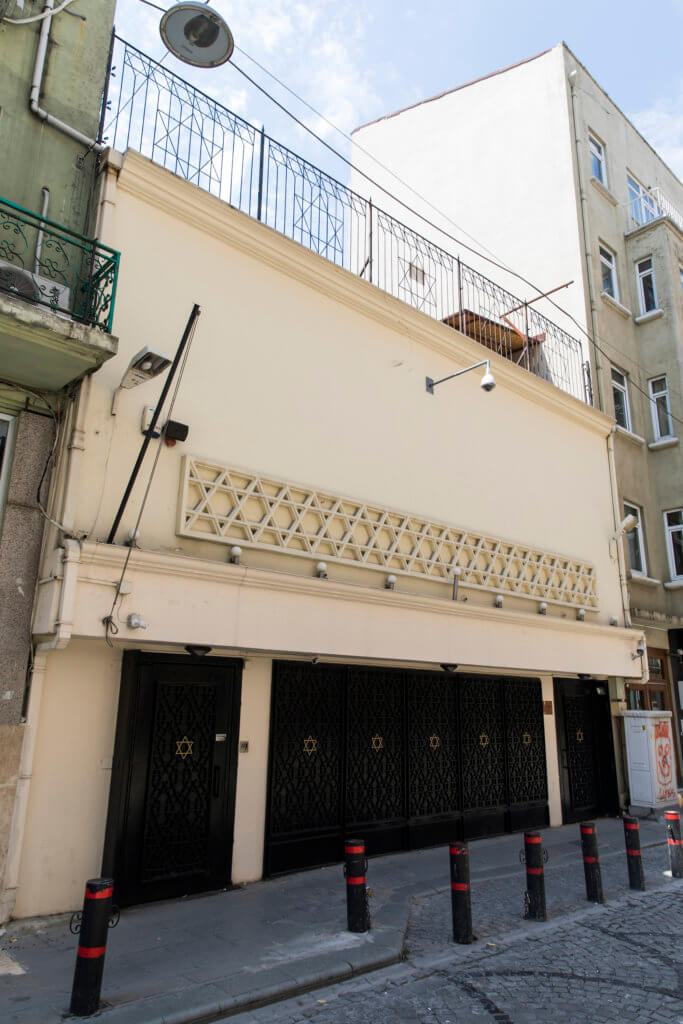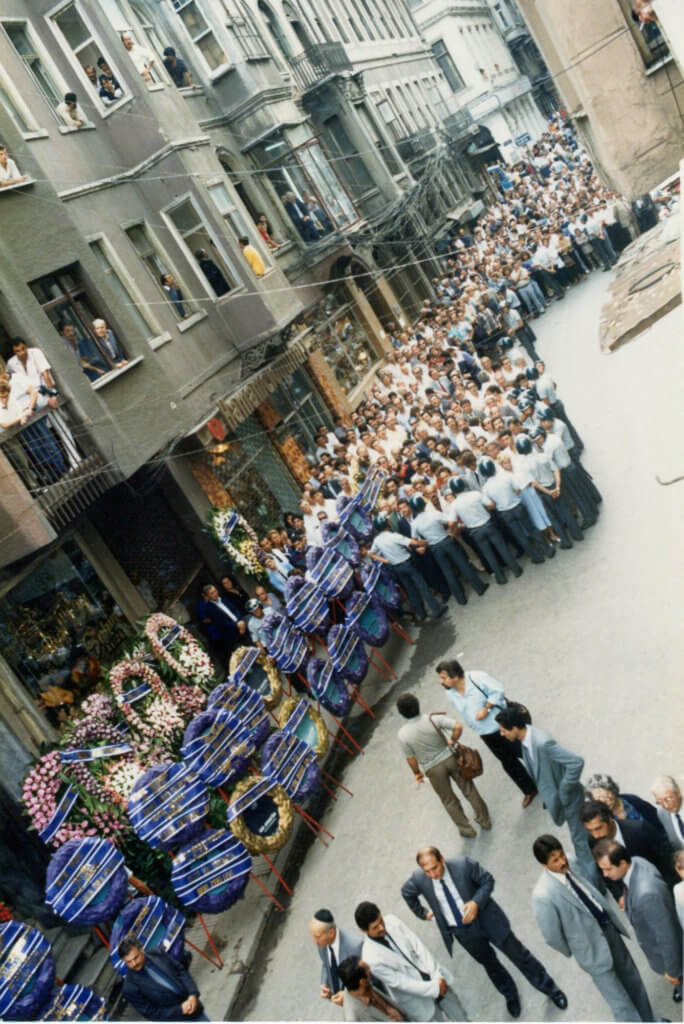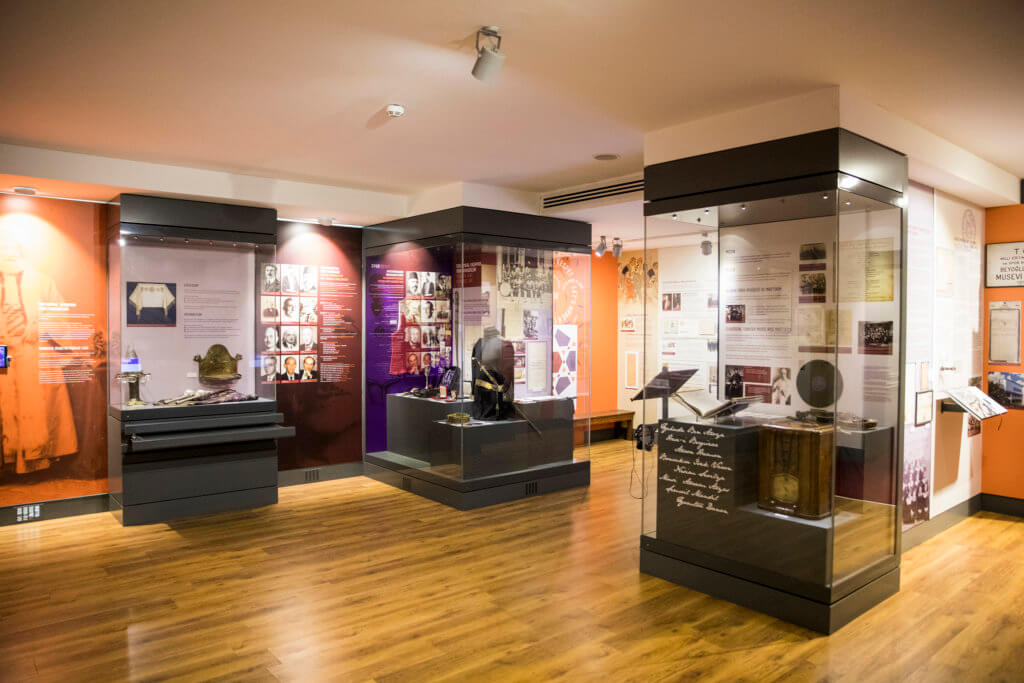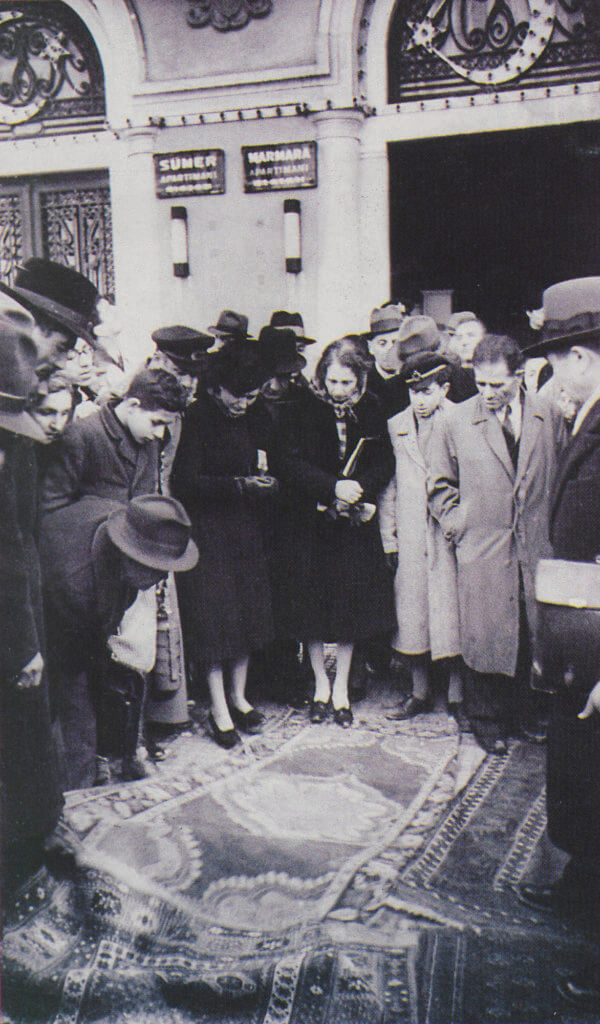NEVE SHALOM SYNAGOGUE
The Neve Shalom Synagogue was converted out of the First Coed Jewish School on Büyük Hendek Avenue and opened in 1938, when the two synagogues in the area became unable to meet the religious needs of the fast-growing Jewish population of Galata and Beyoğlu. The Istanbul Governor’s Office then asked for the building to be reverted back to its original state as a school since the required permissions had not been obtained. Hence, for a while, the school’s ceremony hall was used for worship. On the first day of Pesah (Passover) in 1948, the community administration announced that the new synagogue to be built would be called Neve Shalom, and that for now this name could be used for this hall as well. Neve Shalom means “oasis of peace”, and it is possible to come across synagogues bearing this same name in Istanbul’s past as well.
In 1949 the Galata community obtained permission to build and had Italian architect Denari prepare a project. At this time, Elyo Ventura and Bernar Motola, recent graduates of the Istanbul Technical University, asked to be given an opportunity and designed a project, which was then accepted by the community leaders. Elyo and Bernar’s biggest challenge was to build a dome capable of supporting the weight of the majestic and massive chandelier. The calculations for this dome were made by famous architect Bodin, and it was cast by Master Garbis. The stained-glass designs were drawn in the Academy of Fine Arts, and the glass itself was imported from England. The Neve Shalom Synagogue was opened with a spectacular ceremony on a Sunday morning at 10.30, March 25th 1951, led by Rav Rafael Saban, the then religious leader of the community. In those days the synagogue did not have a façade on the avenue, and it was accessed by way of a narrow corridor. Later, the building in front of it was bought and taken down, and the construction of the front façade was completed in 1960.
THE ATTACKS OF 1986 AND 2003
Though the Neve Shalom Synagogue features in the individual memories of community members with the weddings, circumcisions, funerals, Bar Mitzvah and Bat Mitzvah ceremonies, and religious holidays such as Passovers, Rosh Hashanahs and Yom Kippurs it hosted, it is mostly remembered in the public mind with the two serious attacks it suffered.
The first of these was on the 6th of September 1986, when terrorists entering with explosives and machine guns during Shabat prayers on a Saturday morning at 09:17 took the lives of 22 people. Abu Nadal stood out among organizations that claimed responsibility for the attack. Afterwards, the synagogue was repaired and reopened to worship on the 20th of May 1987 with a well-attended ceremony including state officials. The charred marble on the upper left of the Ehal (or “Ark”), where the Torah scrolls are stored and as such the most sacred part of a synagogue, the clock stopped at 09:17, and the markings of bullets and bombs on a couple of seats were left as was, in order to memorialize that day and make sure it was never forgotten.
The second attack took place on the 15th of November 2003, once again on a Saturday during Shabat prayers. This time terrorists detonated a large quantity of explosives in their cars in front of the synagogue, resulting in the death of 23 people. 6 of these were worshippers, 5 security guards, 1 police officer and 11 people off the street. This second attack was one of a series of suicide bombings conducted on the 15th and 20th of November 2003 by exploding bomb-loaded trucks in four separate locations across Istanbul. The others were those targeting the Beth Israel Synagogue in Şişli roughly around the same time, as well as Istanbul’s British Consulate General and the HSBC bank building in Levent five days later. A total of 59 people lost their lives in these attacks, including the four suicide bombers, while 750 were injured. A Turkish cell of Al-Qaeda was found responsible. A placard with the names of those who lost their lives in both attacks was placed at the inner entrance of the synagogue, where it still stands.
As the walls of Neve Shalom had been fortified following the previous attack, the exterior façade and surrounding buildings suffered serious damage rather than the synagogue’s interior. A 3-meter wide and 2-meter deep crater was formed at the explosion site. The bodies of the six Jews who died in this attack were interred in the front section of the mausoleum built in the Ulus Ashkenazi Jewish Cemetery for the victims of the 1986 attack.
Another smaller scale attack on Neve Shalom took place on a Sunday afternoon, on the 1st of March 1992. Terrorists affiliated with Hezbollah hurled a hand grenade at the synagogue, but the attack did not have much of an effect thanks to new security measures, with only one person slightly injured.
It is often that Jewish citizens of Turkey face the consequences of reactions against Israel. As one of the best-known Jewish sites, Neve Shalom receives its fair share of this. Most recently, on the 20th of July 2017 a group of members of the ultranationalist Alperen Hearths kicked and stoned the Neve Shalom entrance gate, hurling threats such as “We won’t let you in either, we’ll surround all the synagogues,” in reaction to the State of Israel’s installment of metal detectors outside the Al-Aqsa Mosque.
Those who lost their lives
Those who lost their lives in the attack on September 6, 1986
David Behar (Rabbi), Aşer Ergün (Hazzan), Daniel Daryo Baruh (Gabbai), Eliyezer Hara (Gabbai), Yuda Leon Atalay (Shamash), Dr. Moiz Şaul, Leon Levi Musaoğlu, Mirza Ağajan Babazadeh, Rafael Rafi Nassımıha, Binyamin Ereskanazi, Avraam Eskenaz, Jozef Alhalel, İsak Barokas, Bensiyon Levi, Salamon Angel, Şalom Çittone, İbrahim Ergün, İsak Gerşon, Robert İ. Özfis, Moiz Levi, Yako Matalon, Sefanya Şenkal.
Those who lost their lives in the attack on November 15, 2003
Ahmet Özdoğan, Anette Rubinstein Talu, Anna Rubinstein, Avram Varol, Berta Özdoğan, Bülent Bostanoğlu (Police Officer), Emin T. Yakupoğlu (Security Guard), Fasıl Süslü, Hakan Yüksel, İsrael Yoel Ülçer, Kaya Kaya, Mehmet Eruş, Mehmet Ateş (Security Guard), Mesut Gürol, Murat Şahin, Mustafa Yenier (Security Guard), Naşit Gürel (Security Guard), Nurettin Aydın, Oğuz Kızılırmak, Ömer Yazar, Saadet Güneş, Serkan Balcı (Security Guard), Yona Romano.
JEWISH MUSEUM OF TURKEY (OR MUSEUM OF TURKISH JEWS)
Previously located in the Zülfaris Synagogue on Perçemli Street in Karaköy, the Quincentennial Foundation Museum of Turkish Jews (500. Yıl Vakfı Türk Musevileri Müzesi) moved to the Neve Shalom complex in December 2015. Re-erected over its original foundations in 1823, the Zülfaris Synagogue was repaired in 1890 with the financial support of the Camondo (Kamondo) family, and underwent substantial restoration in 1904. After the last wedding that took place here in 1983, it closed down due to a lack of congregation as not many Jews were left in the area. In 1992, the Neve Shalom Synagogue allocated the building to the Quincentennial Foundation to be used as a Museum of Turkish Jews. Moving to its new location after welcoming its visitors here from 2001 to 2015, the museum renewed and updated both its content and exhibition techniques. In this museum composed of three sections the history and cultural heritage of Turkey’s Jewry, as well as their contributions to the country’s social and public/political life, are displayed with complementary chronological information. By virtue of the glass partition separating the Museum from the Neve Shalom Synagogue, visitors are also able to watch religious ceremonies taking place there.
Another important change that came about with the museum’s move to Neve Shalom was the addition of sections on the discrimination faced by Jews under the Republic. These were the 1934 Thrace pogroms against Jewish citizens, the conscription of non-Muslim men into the army in 1941 to serve as labourers under the Ministry of Public Works, the Struma disaster of 1942, and the Wealth Tax Act enacted in 1942. The Quincentennial Foundation’s affirmative discourse regarding the attitude of the Republic and Ottoman Empire towards Jews therefore appears to have been tempered – at least to a certain extent.
Founded in 1989 by 113 Muslim and Jewish citizens of Turkey, the Quincentennial Foundation takes its name from the 500th anniversary of the Ottoman Empire’s acceptance of Sephardic Jews forced to leave Spain in 1492. One of the purposes stated in Article 3 of the Foundation Deed is to “Promulgate both nationally and internationally the humanitarian approach of the Turkish nation, which received with open arms Jews choosing Turkish soil as their homeland in their flight from an environment of bigotry in order to defend their freedom of thought and faith, and support Jewish citizens in their expression of gratitude.” The foundation has organized many an event within this framework both within the country and abroad, working so that Turkey would not be remembered with genocide and rights violations, towards a normalization of relationships with Israel and for EU membership. Whilst doing this, it utterly disregarded the discriminatory politics and anti-Semitism targeting Jews in the Ottoman and Republican eras, highlighting instead the welcoming of Sephardic Jews by the Ottoman Empire in 1492 and of academics fleeing Nazis by the Republic of Turkey during World War II.
The days when I crossed that threshold hopping and skipping, holding my grandfather’s hand, are now a faded memory. That wooden door has been replaced by blast resistant steel, and cells with bulletproof windows I kept calling “mirrored”. An officer would sit behind that glass, at times asking something or another for ‘security’ purposes as was his job. His voice wouldn’t sound human either, warped by the metallic timbre of the speakerphone. I grew up waiting for one of the heavy metal doors to close so that the other would open, and turned more serious in those days. By 2003 I was already a grown-up. A grownup scared for the very first time.
Quoted from a piece written under the pseudonym Hayri Çavuş on the Avlaremoz website.
THE WEALTH TAX (VARLIK VERGİSİ)
The reasoning behind the Wealth Tax (also called “Capital Levy” or “Capital Tax”) enacted on the 11th of November 1942 was professed as taxing the rich from war in order to spread out the burden of economic difficulties, meeting the state’s extraordinarily increasing expenditures by creating new sources of income, decreasing the amount of money in the market and putting an end to the shortage of goods. Appearing well-justified at first glance, in practice this law became a means of targeting non-Muslims, and as such may be considered part of “Turkification” policies that have their origins in the Union and Progress (İttihat ve Terakki) government. Turkification is the attempt to establish the dominance of the Turkish ethnic element in all areas of life from the language spoken to the history to be taught in schools, from trade relations to state bureaucracy. The Wealth Tax aiming to transfer commercial activities from the hands of non-Muslims to Turks may be regarded within the same framework as the incidents of 6-7 September 1955 and the expulsion of Istanbul’s Greek population in 1964.
The memoirs of Faik Ökte, treasurer (“defterdar”) of Istanbul at the time, titled The Tragedy of the Capital Tax (Varlık Vergisi Faciası) (1951) is considered the main source on the matter. In his memoirs, Ökte describes in detail how the tax was imposed in a discriminatory and arbitrary manner. In practice, taxpayers were levied according to one of the four classes determined by the Ministry of Finance: those in the M group (Muslims) were obligated to pay 12.5 percent of the value assessment (i.e. the value taken as basis for taxation), the G group (non-Muslims – “gayrimüslim”) 50 percent, the D group (converts – “dönme”) 23 percent and the E group (foreigners – “ecnebi”) 12.5 percent. Upon the publication of tax lists on the 18th of November 1942 it was seen that 70 percent of Capital Tax revenues were charged to taxpayers in Istanbul, and that 87 percent of these were non-Muslims. The tax rates imposed on non-Muslims were many times heavier than those on Muslims. According to Ökte, of the 315,000,000 liras collected in taxes 280,000,000 were paid by non-Muslims. These figures indicate that non-Muslim citizens of Turkey lost a significant portion of their wealth and possessions between 1942 and 1944.
Having been announced that it was to be levied one-time on the fortunes and extraordinary income of the wealthy and high-income earners, the tax was met favourably, as it meant that the burden of the lower classes would be shared. The shortage of goods and non-Muslims’ alleged benefits from this situation had long been matters of complaint featured in the media. Once more, their economic prosperity had made non-Muslims into a target. This smear campaign continued throughout the summer of 1942, and Jews in particular were used in anti-minority caricatures to represent the wealthy character making a profit off of common people’s backs. Members of commissions that were to determine the tax amounts were Muslim Turks from the Republican People’s Party (CHP). The fact that sums designated by these commissions were fixed and immutable was also inscribed in law; and, as per Article 12, taxpayers were obligated to deposit their amounts within fifteen days. In case of delay, interest would be charged for the first two weeks, and if the indebted party had still not paid at the end of this period, the amount required as tax would be collected via a seizure of their home and businesses. The commissions in question operated under the pressure of nepotism, preferential treatment and special requests, determining sums to be taxed based on subjective opinions rather than concrete facts and according to the ostentatiousness of lifestyles led instead of true wealth.
Some taxpayers who wished to avoid or were unable to pay these excessive taxes tried to escape abroad. Of those who could not or did not wish to run, over 1000 whose properties sold off dirt cheap on short notice did not meet what they owed in taxes were gathered in certain centers as of the 27th of January 1943 in order to be sent to labour camps in Eskişehir’s Sivrihisar district and Aşkale in Erzurum.
The exiles to Aşkale were only able to return home on the 17th of December 1943 as a result of developments on the European front, and on the eve of İsmet İnönü’s visit to Cairo in order to meet with U.S. President Roosevelt and U.K. Prime Minister Churchill. The Capital Tax, on the other hand, was lifted on the 15th of March 1944 as a result of U.S. pressure on Turkey in response to Jews’ efforts in lobbying the U.S. government, and once it became clear that the Nazis would be defeat ed. However, its relentless and merciless implementation until it was lifted negatively affected non-Muslims’ integration into society, and in the following period many members of minority communities migrated to Europe, the United States, and later to Israel after its founding in 1948. Constituting 2.78 percent of the total population in 1927, non-Muslims amounted to 1.08 percent only by 1955. The multi-religious and multi-cultural make-up of Istanbul, which was most affected by the tax, suffered a serious blow. A massive transfer of wealth had taken place: 67 percent of the real estate sold below market value in order to pay the tax was bought by Muslim Turks and 30 percent by official and semi-official state institutions. The press portrayed positively the hand-over of certain buildings on İstiklal Avenue from non-Muslims, perceived as “non-national elements”, to state institutions, even voicing suggestions as to the “Turkification” of Beyoğlu, inhabited by minorities and foreigners and associated with ostentatious over-consumption and waste.
JEWS IN THE OTTOMAN EMPIRE AND TURKEY
Jews constitute the second largest group after Armenians among Turkey’s dwindling minorities. Looking at the size of the non-Muslim population in the censuses of 1914 and 2015, the sheer dimensions of the difference in proportion become painfully evident: while non-Muslims made up 20 percent of the total population of 13,500,000 (1,700,000 Armenians / 1,553,000 Greeks / 136,000 Jews) in 1914, come 2015 non-Muslims are only 1 percent of the population that has reached a total of 70,000,000 (50,000 Armenians / 3000 Greeks / 17,000 Jews).
When the Ottomans overtook Bursa pushing out the Byzantines in 1324, a Jewish community was in existence there. Those expelled from European lands in the 14th century had also taken refuge in the Ottoman Empire, but the actual wave of migration took place when Sephardic Jews were banished from the domains of Spain and Portugal in 1492. Jews displaced from Italy and Bohemia in the same period also sought shelter in Ottoman lands. Under the millet (“communities” or “nations”) system, all non-Muslims had broad autonomy in areas of faith, worship and education, but were subject to certain restrictions in the social realm. Their homes had to be of different colour and height, their clothing of different materials and colour, and they could not ride horses without permission. Non-Muslims were not allowed to bear arms or serve as soldiers; and they could not hold high-ranking public office in sovereignty-related roles. Still, they were not expected to assimilate into the dominant millet – or community.
Policies of Turkification put into effect as of the Union and Progress era, on the other hand, aimed to marginalize and exclude non-Muslims, and homogenize the population. Jews were not subjected to genocide or mass displacement as were Armenians and Greeks, but they faced all kinds of discrimination, and even ventures at mass looting and expulsion. Rıfat Bali, author of many important works on the history of Jews in Turkey, claims that Jews were never considered full-fledged citizens in the Republic of Turkey, one professing to be secular.
“Citizen, Speak Turkish!” (“Vatandaş Türkçe Konuş”) campaigns organized in the early years of the Republic directly targeted Jews. In these campaigns waged using force, those who did not speak Turkish in public faced repression. What set Jews apart from Armenians and Greeks was that the language they spoke was not Hebrew, which the state recognized as a national language, but first Spanish, and later – with the influence of the Alliance schools – French. Their speaking the language of the country that had banished them was interpreted as ingratitude, and French as a sign of disdain for Turkish. The public at large and press thus constantly criticized Jews. They blamed them for not becoming Turkish enough in general, and for not internalizing Turkish culture.
The “Thrace Incidents” took place in 1934. The region’s proximity to the Greek and Bulgarian borders made it easier to perceive Jews living there as potential enemies and threats. In the month of June, Jews were first compelled to speak Turkish, then they were boycotted and banned from selling their property, and finally forced to migrate through instilling fear, intimidation, battery and rape. During attacks occurring from the 28th of June to 4th of July 1934 in Çanakkale, Kırklareli, Babaeski, Lüleburgaz, Edirne and Uzunköprü security forces did not take the measures necessary. The government put the blame on local administrators and claimed to have not been informed of the attacks. In the aftermath of these incidents a great majority of Thracian Jews migrated to Istanbul leaving all of their possessions and properties behind, and after 1942, this flow turned abroad. The imposition of the Capital Tax, enacted in 1942 for the hand-over of non-Muslims properties and possessions to the state so as to be converted into Turkish capital, became the first practice directly hitting Jews after the Thrace Incidents.
Though Turkey had declared its neutrality during World War II, it refused to give visas to Jews fleeing Germany and only ended up accepting a handful of academics to work in universities. While some argue that diplomats form Turkey rescued 35,000 Jews at the time, historian Corry Guttstadt demonstrates how the Turks handed 25,000 Jews of Ottoman/Turkish descent living in Europe over to the Nazis’ genocidal apparatus. Thousands of Jews, who had migrated to Europe in the late Ottoman period or after the founding of the Republic of Turkey and had had their citizenships revoked for not having registered with a consulate by the end of five years, were left in camps and abandoned to death despite Germany’s calls to Turkey to “repatriate its citizens as a neutral country”.
The Turkish state was also responsible for the death of 781 Jews and 10 crew on the Struma, as it did not grant this ship that broke down on its way from Romania to Palestine during World War II permission to land and disembark, thus causing those on board to first grapple with hunger and disease, then towing them off to the coast of Şile where the ship was sunk by a Soviet submarine. Britain had also played a part in preventing the ship from going to Palestine, since it had concluded that the administration it had established there would be endangered by a mass migration of Jews.
Today, 90 percent of Jews in Turkey live in Istanbul. The most crowded population outside Istanbul is in İzmir, with 1500. There are very small Jewish populations in Adana, Ankara, Bursa, Çanakkale, İskenderun and Kırklareli. For reasons such as “Citizen, Speak Turkish!” campaigns, the exclusion resulting from speaking with an accent, and a desire to avoid being outwardly perceivable as Jewish, many Jews turkified their names and surnames, and younger generations did not learn the Judeo-Spanish language. In this manner, Jews tried to protect themselves from the rampant anti-Semitism in society.
Recent steps by Spain and Portugal to grant Jews expelled in 1492 the right to apply for citizenship mobilized Jews from Turkey wishing to become EU citizens and take advantage of visa exemptions. Turkey’s Jews have migrated to the West and, since its founding, to Israel as well. The factors triggering this migration have been troubles in the relations between Turkey and Israel, the pogrom of 6-7 September, the Coup of May 27, clashes between the left and right in the 1970s, political crises such as the Coup of September 12 as well as economic crises and anti-Semitic waves rising among Turkey’s Islamist and nationalist factions in response to wars or military operations involving Israel in the Middle East. Contrary to common belief, there has been no serious migration away from Turkey in recent years. Still, the problems Turkey has lately been suffering, the rise of authoritarianism, increasing polarization, as well as the fact that reactions against the state of Israel often directly target Jews living in Turkey, cause young Jewish citizens in particular to contemplate leaving.
The state of Turkey, while on the one hand spending 2,500,000 dollars for the restoration of the Grand Synagogue in Edirne, and holding United Nations Holocaust Remembrance Day ceremonies, and even Struma commemorations, on the other turns a blind eye to quite rampant anti-Semitic hate speech, at times even actively reproducing it, and makes no effort whatsoever to prevent its own Jewish citizens from being made into targets.



